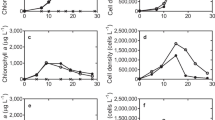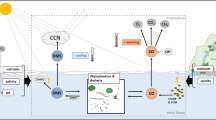Abstract
Dimethylsulfide (DMS) concentrations in sea water were found to be high (0.19 to 390 nM) in an Antarctic bloom of Phaeocystis sp. during October and November 1990. DMS concentrations were positively correlated with algal pigments, particularly 19′-hexanoyloxyfucoxanthin, a prymnesiophyte pigment. Concentrations of DMS varied diurnally, possibly due to effects of sunlight, although the exact mechanism is unknown. Since oceanic DMS production has been linked to the global albedo through the formation of cloud condensation nuclei, light-mediated changes in DMS concentrations may affect the global climate. The flux of DMS from this bloom into the atmosphere is calculated to be 67±55 μmol m-2 d-1.
Similar content being viewed by others
References
Andreae MO (1986) The ocean as a source of atmospheric sulfur compounds. In: Buat-Menard P (ed) The role of air-sea exchange in geochemical cycling. Reidel, Dordrecht, pp 331–362
Andreae MO (1990) Ocean-atmosphere interactions in the global biogeochemical sulfur cycle. Mar Chem 30: 1–29
Andreae WT, Andreae MO, Bingemer HG (1993) Measurements of dimethyl sulfide and H2S over the western North Atlantic and the tropical Atlantic. J geophys Res 98 (D12): 23389–23396
Andreae MO, Barnard WR (1983) Determination of trace quantities of dimethyl sulfide in aqueous solutions. Analyt Chem 55: 608–612
Ayers GP, Ivey JP, Gilett RW (1991) Coherence between seasonal cycles of dimethyl sulfide, methanosulphonate and sulphate in marine air. Nature, Lond 349: 404–406
Barnard WR, Andreae MO, Iverson RL (1984) Dimethylsulfide and Phaeocystis pouchetii in the southeastern Bering Sea. Contin Shelf Res 3: 103–113
Bates TS, Charlson RJ, Gammon RH (1987) Evidence for the climatic role of marine biogenic sulphur. Nature, Lond 329: 319–321
Baumann MEM, Brandini FP, Staubes R (1994) The influence of light and temperature on carbon-specific DMS release by cultures of Phaeocystis antarctica and three antarctic diatoms. Mar Chem 45: 129–136
Berresheim H (1987) Biogenic sulfur emissions from the subarctic and Antarctic oceans. J geophys Res 92 (D11): 13245–13262
Bidigare RR, Itiarte JL, Kang SH, Ondrusek ME, Karentz D, Fryxell GA (1995) Phytoplankton: quantitative and qualitative assessments. In: Ross A, Hofmann E, Quetin L (eds) Foundations for ecosystem research in the western Antarctic Peninsula Region. Antarctic Research Series, American Geophysical Union, Washington DC (in press)
Bidigare RR, Kennicutt ME III, Ondrusek ME, Keller MD, Guillard RRL (1990) Novel chlorophyll-related compounds in marine phytoplankton: distributions and geochemical implications. Energy Fuels 4: 653–657
Bidigare RR, Smith RC, Baker KS, Marra J (1987) Oceacic primary production estimates from measurements of spectral irradiance and pigment concentrations. Global biogeochem Cycles 1: 171–186
Bjørnland T, Guillard RRL, Liaaen-Jensen S (1988) Phaeocystis sp. clone 677-3—a tropical marine planktonic prymnesiophyte with fucoxanthin and 19′-acyloxyfucoxanthins as chemosystematic carotenoid markers. Biochem Syst Ecol 16: 445–452
Brimblecombe P, Shooter D (1986) Photo-oxidtion of dimethylsulfide in aqueous solution. Mar Chem 19: 343–353
Challenger F, Bywood R, Thomas P, Heywood BJ (1957) Studies on biological methylation. XVII. The natural occurrence and chemical reactions of some thetins. Archs Biochem Biophys 69: 514–523
Challenger F, Simpson MI (1948) Studies on biological methylation. XII. A precursor of the dimethyl-sulfide evolved by Polysiphonia fastigiata: dimethyl-2-carboxyethyl sulphonium hydroxide and its salt. J chem Soc 3: 1591–1597
Charlson RJ, Lovelock JE, Andreae MO, Warren SG (1987) Oceanic phytoplankton, atmospheric sulphur, cloud albedo and climate. Nature, Lond 326: 655–661
Colt J (1984) Computation of dissolved gas concentrations in water as functions of temperature salinity and pressure. American Fisheries Society Special Publication #14, American Fisheries Society, Bethesda, Maryland
Dacey JWH, Wakeham SG (1986) Oceanic dimethysulfide: production during zooplankton grazing on phytoplankton. Science, NY 233: 1314–1316
Deprez PP, Franzmann PD, Burton HR (1986) Determination of reduced sulfur gases in Antarctic lakes and seawater by gas chromatography after solid adsorbent preconcentration. J Chromat 362: 9–21
Fredrick JE, Snell H (1988) Ultraviolet radiation levels during the Antarctic spring. Science, NY 241: 438–440
Gibson JAE, Garrick RC, Burton HR, McTaggart AR (1988) Dimethylsulfide concentrations in the ocean close to the Antarctic continent. J Geomicrobiol 6: 179–184
Gras JL (1990) Cloud condensation nuclei over the southern ocean. Geophys Res Lett 17: 1565–1567
Holligan PM, Turner SM, Liss PS (1987) Measurements of dimethyl sulfide from frontal regions. Contin Shelf Res 7: 213–224
Karsten U, Wiencke C, Kirst GO (1991) Growth pattern and b-dimethylsulphopropionate (DMSP) content of green macroalgae at different irradiances. Mar Biol 108: 151–155
Keller MD, Bellows WK, Guillard RRL (1989) Dimethyl sulfide production in marine phytoplankton. In: Saltzman ES, Cooper WJ (eds) Biogenic sulfur in the environment. American Chemical Society, Washington DC, pp 183–200
Kiene RP, Bates TS (1990) Biological removal of dimethyl sulphide from sea water. Nature, Lond 345: 702–705
Lawrence MG (1993) An empirical analysis of the strength of the phytoplankton-dimethylsulfide-cloud-climate feedback cycle. J geophys Res 98 (D11): 20663–20673
Leck C, Larsson U, Bågander LE, Johansson S, Hajdu S (1990) Dimethyl sulfide in the Baltic Sea: annual variability in relation to biological activity. J geophys Res 95 (C3): 3353–3363
Liss PS, Merlivat L (1985) Air-sea gas exchange rates: introduction and synthesis. In: P Buat-Menard (ed) The role of air-sea exchange in geochemical cycling. Reidel, Dordrecht, pp 113–127
MacIntyre S, Wanninkhof R, Chanton J (1995) Trace gas exchange across the air-water interface in freshwater and coastal marine environments In: Matson P, Harris R (eds) Methods in ecology: trace gases. Blackwell Scientific Publications, Oxford (in press)
Malin G, Turner SM, Liss PS (1992) Sulfur: the plankton/climate connection. J Phycol 28: 590–597
Malin G, Turner S, Liss P, Holligan P, Harbour D (1993) Dimethylsulphide and dimethylsulphopropionate in the Northeast Atlantic during the summer coccolithophore bloom. Deep-Sea Res 40: 1487–1508
Miller DGM, Hampton I (1989) Biology and ecology of the Antarctic krill (Euphausia superba Dana): a review. Biomass. Vol. 9. SCAR and SCOR publishers, Scott Polar Research Institute, Cambridge, England
Nguyen BC, Belviso S, Mihalopoulos N, Gostan J, Nival P (1988) Dimethyl sulfide production during natural phytoplankton blooms. Mar Chem 24: 133–141
Prospero JM, Savoie DL, Saltzmann ES, Larsen R (1991) Impact of oceanic sources of biogenic sulphur on sulphate aerosol concentrations at Mawson, Antarctica. Nature, Lond 350: 221–223
Putaud J-P, Belviso S, Nguyen BC, Mihalopoulos N (1993) Dimethylsulfide, aerosols, and condensation nuclei over the tropical northeastern Atlantic Ocean. J geophys Res 98 (D8): 14863–14871
Quinn PK, Covert DS, Bates TS, Kapustin VN, Ramsey-Bell DC, McInnes LM (1993) Dimethylsulfide/cloud condensation nuclei/climate system: relevant size-resolved measurements of the chemical and physical properties of atmospheric aerosol particles. J geophys Res 98 (D6): 10411–10427
Schwartz SE (1988) Are global cloud albedo and climate controlled by marine phytoplankton? Nature, Lond 336: 441–445
Sievering H, Boatman J, Gorman E, Kim Y, Anderson L, Ennis G, Luria M, Pandis S (1992) Removal of sulphur from the marine boundary layer by ozone oxidation in sea-salt aerosols. Nature, Lond 360: 571–573
Smith RC, Baker KS (1984) Analysis of ocean optical data. Ocean Optics 7, Proc Soc Photo-opt Instrmn Engrs 489: 119–126
Smith RC, Prézelin BB, Baker KS, Bidigare RR, Boucher NP, Coley T, Karentz D, MacIntyre S, Matlick HA, Menzies D, Ondrusek M, Wan Z, Waters KJ (1992) Ozone depletion: ultraviolet radiation and phytoplankton biology in Antarctic waters. Science, NY 255: 952–959
Solomon S (1990) Progress towards a quantitative understanding of Antarctic ozone depletion. Nature, Lond 347: 347–354
Turner SM, Malin G, Liss PS, Harbour DS, Holligan PM (1988) The seasonal variation of dimethyl sulfide and dimethylsulfoniopropionate concentrations in near-shore waters. Limnol Oceanogr 33: 364–375
Wanninknof RH, Bliven LF (1991) Relationship between gas exchange, wind speed and radar backscatter in a large wind-wave tank. J geophys Res 96 (C2): 2785–2796
Wright SW, Jeffrey SW, Mantoura RFC, Llewellyn CA, Bjørnland T, Repeta D, Welschmeyer N (1991) Improved HPLC method for the analysis of chlorophylls and carotenoids from marine phytoplankton. Mar Ecol Prog Ser 77: 183–196
Yin F, Grosjean D, Flagan R, Seinfeld JH (1990) Photooxidation of dimethyl sulfide and dimethyl disulfide. II. Mechanism evaluation. J atmos Chem 11: 365–399
Author information
Authors and Affiliations
Additional information
Communicated by J. P. Grassle, New Brunswick
Rights and permissions
About this article
Cite this article
Crocker, K.M., Ondrusek, M.E., Petty, R.L. et al. Dimethylsulfide, algal pigments and light in an Antarctic Phaeocystis sp. bloom. Marine Biology 124, 335–340 (1995). https://doi.org/10.1007/BF00347137
Received:
Accepted:
Issue Date:
DOI: https://doi.org/10.1007/BF00347137




